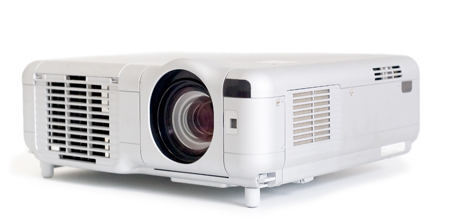The projection of images onto a screen is particularly effective because the increased size of the projected image enables large numbers of people to view photographs simultaneously. However, the quality of a projected image is dependent upon a number of factors including:
- the definition or resolution, sharpness, colour saturation and physical size of the original image;
- the optical quality of the projection lens;
- the nature, quality and flatness of the projection screen,
- the position of the projection lens in relation to the centre of the screen; and
- the colour balance achieved when using a digital projector.
Larger-format transparencies, such as the common 6 x 4.5 and 6 x 6 formats, can be magnified only to the same extent as their 35mm counterparts. However, the lager size of the original image allows a much larger projected image to be achieved for the same magnification.
 |
| Public domain image by Silvio Mechow |
The quality of a projection lens is also a limiting factor. transparencies captured using the highest-quality lenses are of little benefit when projected using a poorly-focused low-quality plastic zoom lens. When a photographer has taken care to produce excellent work with expensive camera equipment it is worth also spending money on a good projector lens.
Projection screens are available with a number of different surfaces. The two most common types are the matte and glass-bead surfaces. Matt surfaces generally reflect a less brilliant image but over a wider angle of view. Glass-bead surfaces exhibit excellent brilliance over a relatively narrow field of view, but this drops off rapidly as the field of view widens. Any projection screen must also maintain a plane surface so that the projected image is uniformly sharp. Many of the larger rolled screens tend to curl inwards at the edges, so limiting the use of their full area.
When projecting slides onto a screen, the projector should be positioned on a firm base and aligned with the centre of the screen in both the horizontal and vertical planes. This eliminates diverging verticals and other unsightly distortions of the projected image. Small transparencies, typically those of the 35mm format, can usually be enlarged to an extent sufficient for a presentation to perhaps 100 people - perhaps about 5 or 6 feet wide and 3 or 4 feet high. Further magnification may reveal significant limitations such as lack of sharpness and definition, and diminishing colour saturation.
When using a digital projection system, it is important to calibrate the machine accurately to achieve proper colour balance. The magnification of the projected image is limited by resolution and sharpness in a manner comparable to traditional slide projectors. The lamps for digital projectors are easily damaged and expensive to replace.